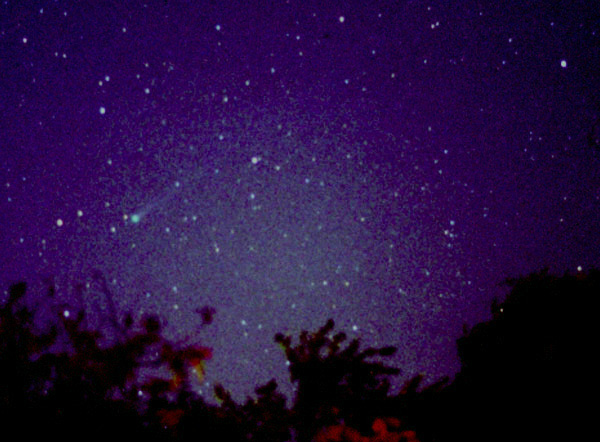

COMET OF THE WEEK
WEEK 25: JUNE 14-20
COMET LINEAR C/2001 A2
Perihelion: 2001 May 24.52, q = 0.779 AU
The first moderately bright naked-eye comet of the 21st Century was discovered by LINEAR on January 15, 2001, with pre-discovery images extending back to January 3 later being identified. The comet was a relatively dim 16th or 17th magnitude at the time of its discovery, and although the moderately small perihelion distance suggested it would become bright enough for visual observations, there otherwise didn’t seem to be anything unusual about it, and it brightened slowly as it approached the inner solar system. Around mid-March, however, it underwent a rapid increase in brightness, from about 13th magnitude at that time to close to 8th magnitude shortly after the beginning of April.


Comet LINEAR's brightness surge did not stop then, although it proceeded further in fits and starts rather than continuously. By the beginning of May its brightness had increased to 6th magnitude; shortly thereafter it became inaccessible from the northern hemisphere, although it remained visible from the southern hemisphere, with observers there reporting it as being close to 5th magnitude during the latter part of that month before it passed through conjunction with the sun (50 degrees south of it) in early June, after which it emerged into the southern hemisphere's morning sky.
By the latter part of June Comet LINEAR had faded slightly, to about 4th magnitude, and also had become accessible again from the northern hemisphere. It passed closest to Earth (0.24 AU) at the very end of the month and faded somewhat steadily after that point; there were reports of a brief outburst around the middle of July, but within another week it had dropped below naked-eye visibility. After going through opposition at the beginning of August it faded more rapidly, with visual observations remaining possible until early September and the final observations being obtained three months later.


LEFT: Photograph of Comet LINEAR I took on the morning of June 16, 2001, from the outskirts of Harare, Zimbabwe. RIGHT: CCD image of Comet LINEAR taken remotely by Muazzez Lohmiller on July 21, 2001, with the Center for Astrophysics MicroObservatory network. Courtesy Muazzez Lohmiller.
“Comet of the Week” archive
Ice and Stone 2020 home page
Earthrise Institute home page